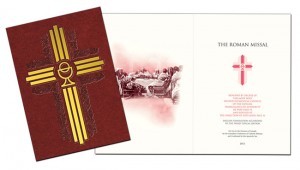And with your spirit
Deacon Pedro
Thursday, September 29, 2011
 As many of you know, there is a new English translation of the Mass and the changes will be implemented beginning this coming Advent. Salt + Light is working with the National Liturgy Office of the Canadian Conference of Catholic Bishops on a DVD that will be used for ongoing catechesis on the Mass. We have been filming several Masses using the new translation.
As many of you know, there is a new English translation of the Mass and the changes will be implemented beginning this coming Advent. Salt + Light is working with the National Liturgy Office of the Canadian Conference of Catholic Bishops on a DVD that will be used for ongoing catechesis on the Mass. We have been filming several Masses using the new translation.
Related Articles:
Category: General Posts
Tag: Saints
Uncovering the Legacy of Fr. David Bauer: A Hidden Piece of Canadian History
Tuesday, March 4, 2025
 Alessandro Adorante
Alessandro Adorante
Priest, educator, and legendary hockey coach. Fr. David Bauer's impact on Canada's sports and culture history is unmistakable.
My Manresa Story: Resting a While
Monday, February 24, 2025
 Gianpaolo Capozzi
Gianpaolo Capozzi
At the Manresa Spiritual Renewal Centre in Pickering, ON, retreatants of all ages can encounter a God of surprises.
A House Not Made With Hands: St. Anne’s Anglican Church
Friday, February 21, 2025
 Scott Harris
Scott Harris
In June, 2024, the domed roof and interior of St. Anne's Anglican Church in Toronto tragically burned down. However, the parish community continues to stand strong and serve its neighbourhood.
Pray with Pope Francis Reflection – February 2025
Friday, February 7, 2025
 Fr. Edmund Lo, SJ
Fr. Edmund Lo, SJ
Pope Francis invites us to pray for vocations to the priesthood and religious life, that the ecclesial community might welcome the desires and doubts of those young people who feel a call to serve Christ’s mission in the priesthood and religious life.
Pray with Pope Francis Reflection – January 2025
Tuesday, January 7, 2025
 Fr. Edmund Lo, SJ
Fr. Edmund Lo, SJ
Pope Francis invites us to pray for the right to an education for migrants, refugees and those affected by war; that their right to an education, which is necessary to build a better world, may always be respected.













